2009 SUBARU FORESTER tire pressure
[x] Cancel search: tire pressurePage 362 of 384
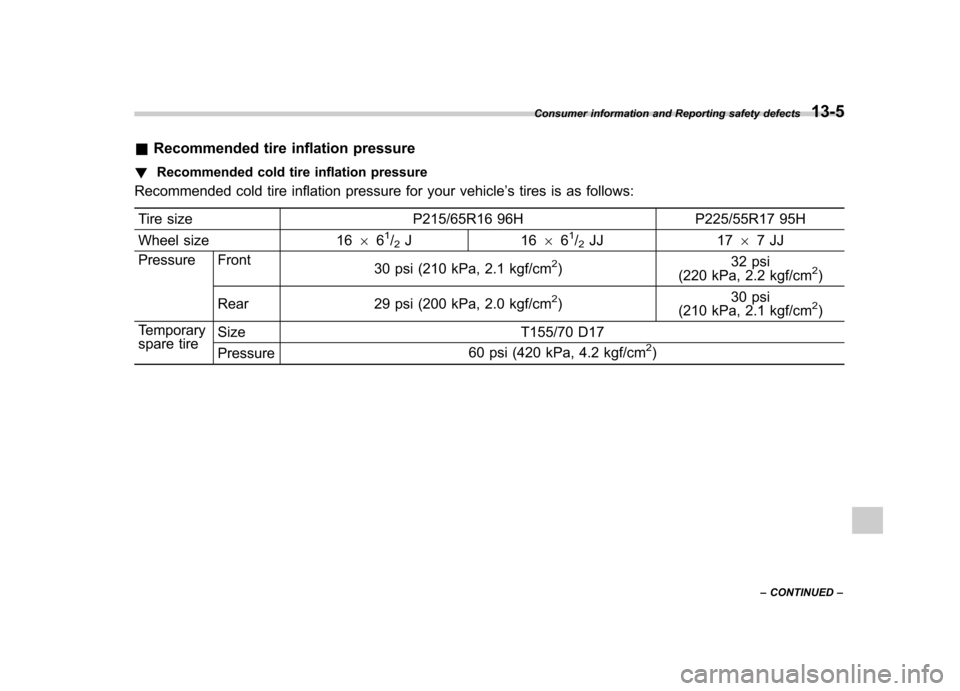
&Recommended tire inflation pressure
! Recommended cold tire inflation pressure
Recommended cold tire inflation pressure for your vehicle ’s tires is as follows:
Tire size P215/65R16 96H P225/55R17 95H
Wheel size 16 66
1/2J1 66 61/2JJ 17 67JJ
Pressure Front 30 psi (210 kPa, 2.1 kgf/cm
2)32 psi
(220 kPa, 2.2 kgf/cm2)
Rear 29 psi (200 kPa, 2.0 kgf/cm
2) 30 psi
(210 kPa, 2.1 kgf/cm2)
Temporary
spare tire Size
T155/70 D17
Pressure 60 psi (420 kPa, 4.2 kgf/cm
2)
Consumer information and Reporting safety defects
13-5
– CONTINUED –
Page 363 of 384
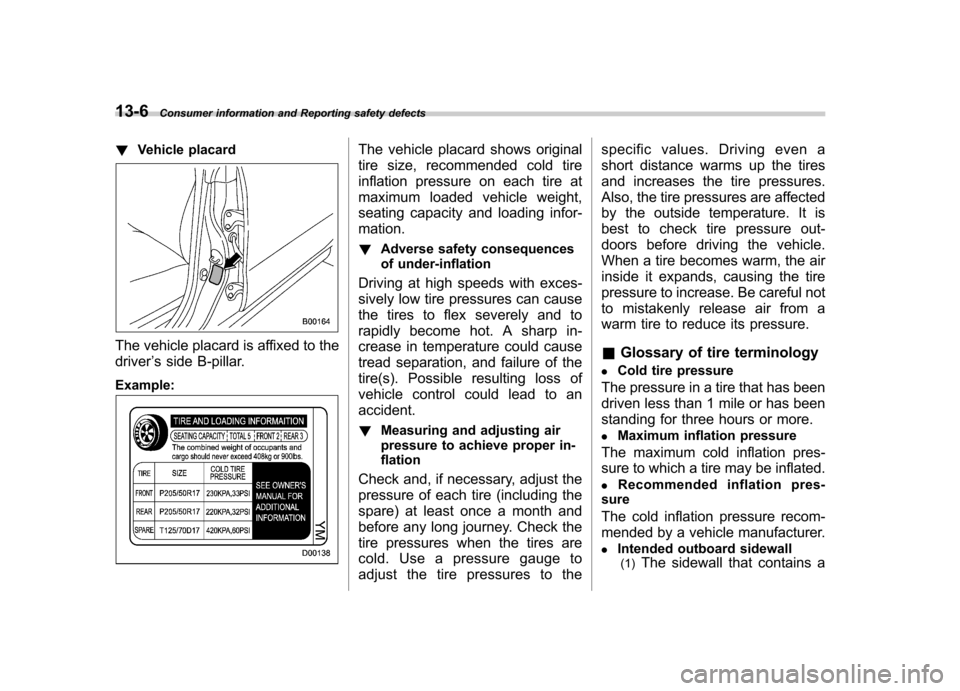
13-6Consumer information and Reporting safety defects
! Vehicle placard
The vehicle placard is affixed to the driver ’s side B-pillar.
Example:
The vehicle placard shows original
tire size, recommended cold tire
inflation pressure on each tire at
maximum loaded vehicle weight,
seating capacity and loading infor-mation. ! Adverse safety consequences
of under-inflation
Driving at high speeds with exces-
sively low tire pressures can cause
the tires to flex severely and to
rapidly become hot. A sharp in-
crease in temperature could cause
tread separation, and failure of the
tire(s). Possible resulting loss of
vehicle control could lead to anaccident. ! Measuring and adjusting air
pressure to achieve proper in-
flation
Check and, if necessary, adjust the
pressure of each tire (including the
spare) at least once a month and
before any long journey. Check the
tire pressures when the tires are
cold. Use a pressure gauge to
adjust the tire pressures to the specific values. Driving even a
short distance warms up the tires
and increases the tire pressures.
Also, the tire pressures are affected
by the outside temperature. It is
best to check tire pressure out-
doors before driving the vehicle.
When a tire becomes warm, the air
inside it expands, causing the tire
pressure to increase. Be careful not
to mistakenly release air from a
warm tire to reduce its pressure. &
Glossary of tire terminology
. Cold tire pressure
The pressure in a tire that has been
driven less than 1 mile or has been
standing for three hours or more.. Maximum inflation pressure
The maximum cold inflation pres-
sure to which a tire may be inflated. . Recommended inflation pres-
sure
The cold inflation pressure recom-
mended by a vehicle manufacturer.. Intended outboard sidewall
(1) The sidewall that contains a
Page 365 of 384
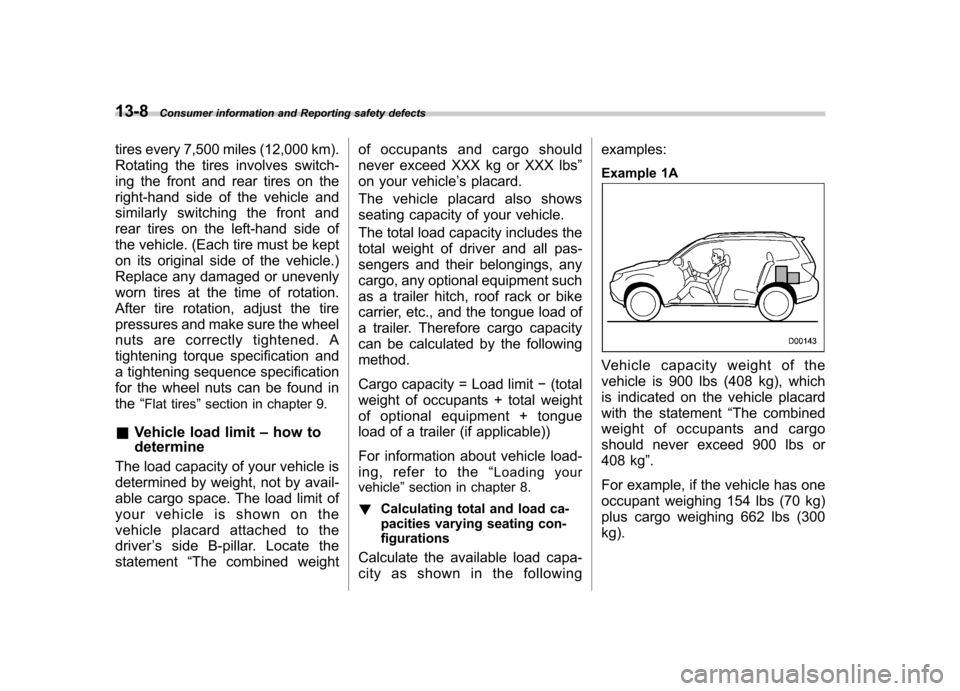
13-8Consumer information and Reporting safety defects
tires every 7,500 miles (12,000 km).
Rotating the tires involves switch-
ing the front and rear tires on the
right-hand side of the vehicle and
similarly switching the front and
rear tires on the left-hand side of
the vehicle. (Each tire must be kept
on its original side of the vehicle.)
Replace any damaged or unevenly
worn tires at the time of rotation.
After tire rotation, adjust the tire
pressures and make sure the wheel
nuts are correctly tightened. A
tightening torque specification and
a tightening sequence specification
for the wheel nuts can be found inthe “Flat tires
”section in chapter 9.
& Vehicle load limit –how to
determine
The load capacity of your vehicle is
determined by weight, not by avail-
able cargo space. The load limit of
your vehicle is shown on the
vehicle placard attached to the
driver ’s side B-pillar. Locate the
statement “The combined weight of occupants and cargo should
never exceed XXX kg or XXX lbs
”
on your vehicle ’s placard.
Thevehicleplacardalsoshows
seating capacity of your vehicle.
The total load capacity includes the
total weight of driver and all pas-
sengers and their belongings, any
cargo, any optional equipment such
as a trailer hitch, roof rack or bike
carrier, etc., and the tongue load of
a trailer. Therefore cargo capacity
can be calculated by the followingmethod.
Cargo capacity = Load limit �(total
weight of occupants + total weight
of optional equipment + tongue
load of a trailer (if applicable))
For information about vehicle load-
ing, refer to the “Loading your
vehicle ”section in chapter 8.
! Calculating total and load ca-
pacities varying seating con-
figurations
Calculate the available load capa-
city as shown in the following examples:
Example 1A
Vehicle capacity weight of the
vehicle is 900 lbs (408 kg), which
is indicated on the vehicle placard
with the statement
“The combined
weight of occupants and cargo
should never exceed 900 lbs or
408 kg ”.
For example, if the vehicle has one
occupant weighing 154 lbs (70 kg)
plus cargo weighing 662 lbs (300kg).
Page 377 of 384
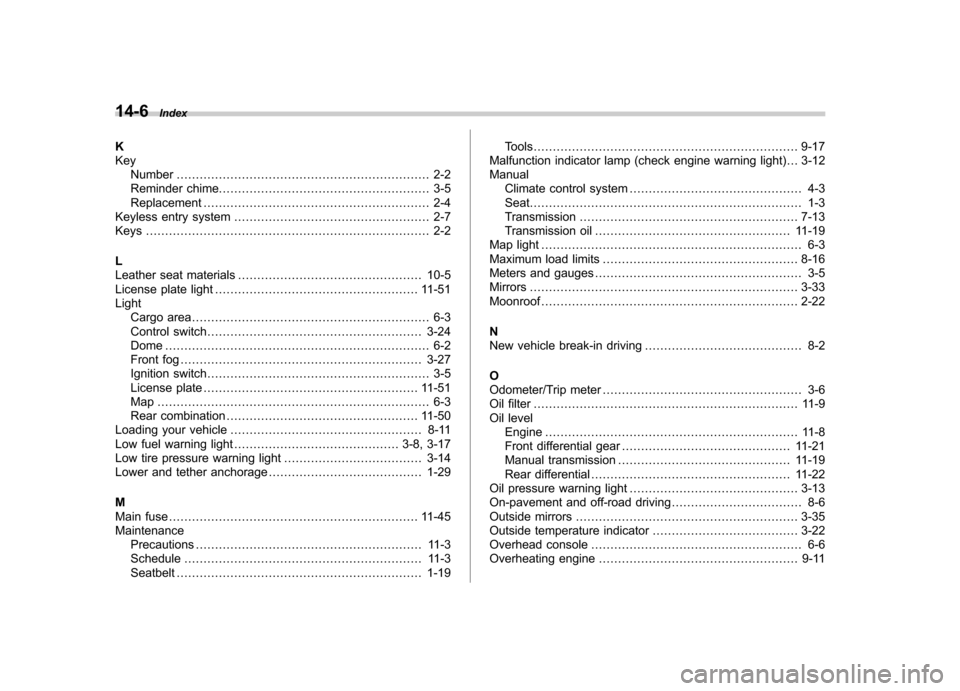
14-6Index
K Key Number .................................................................. 2-2
Reminder chime. ...................................................... 3-5
Replacement ........................................................... 2-4
Keyless entry system ................................................... 2-7
Keys .......................................................................... 2-2
L
Leather seat materials ................................................ 10-5
License plate light ..................................................... 11-51
Light Cargo area .............................................................. 6-3
Control switch ........................................................ 3-24
Dome ..................................................................... 6-2
Front fog ............................................................... 3-27
Ignition switch .......................................................... 3-5
License plate ........................................................ 11-51
Map ....................................................................... 6-3
Rear combination .................................................. 11-50
Loading your vehicle .................................................. 8-11
Low fuel warning light ........................................... 3-8, 3-17
Low tire pressure warning light .................................... 3-14
Lower and tether anchorage ........................................ 1-29
M
Main fuse ................................................................. 11-45
Maintenance Precautions ........................................................... 11-3
Schedule .............................................................. 11-3
Seatbelt ................................................................ 1-19 Tools
..................................................................... 9-17
Malfunction indicator lamp (check engine warning light)... 3-12 Manual
Climate control system ............................................. 4-3
Seat ....................................................................... 1-3
Transmission ......................................................... 7-13
Transmission oil ................................................... 11-19
Map light .................................................................... 6-3
Maximum load limits ................................................... 8-16
Meters and gauges ...................................................... 3-5
Mirrors ...................................................................... 3-33
Moonroof ................................................................... 2-22
N
New vehicle break-in driving ......................................... 8-2
O
Odometer/Trip meter .................................................... 3-6
Oil filter ..................................................................... 11-9
Oil level Engine .................................................................. 11-8
Front differential gear ............................................ 11-21
Manual transmission ............................................. 11-19
Rear differential .................................................... 11-22
Oil pressure warning light ............................................ 3-13
On-pavement and off-road driving .................................. 8-6
Outside mirrors .......................................................... 3-35
Outside temperature indicator ...................................... 3-22
Overhead console ....................................................... 6-6
Overheating engine .................................................... 9-11
Page 380 of 384
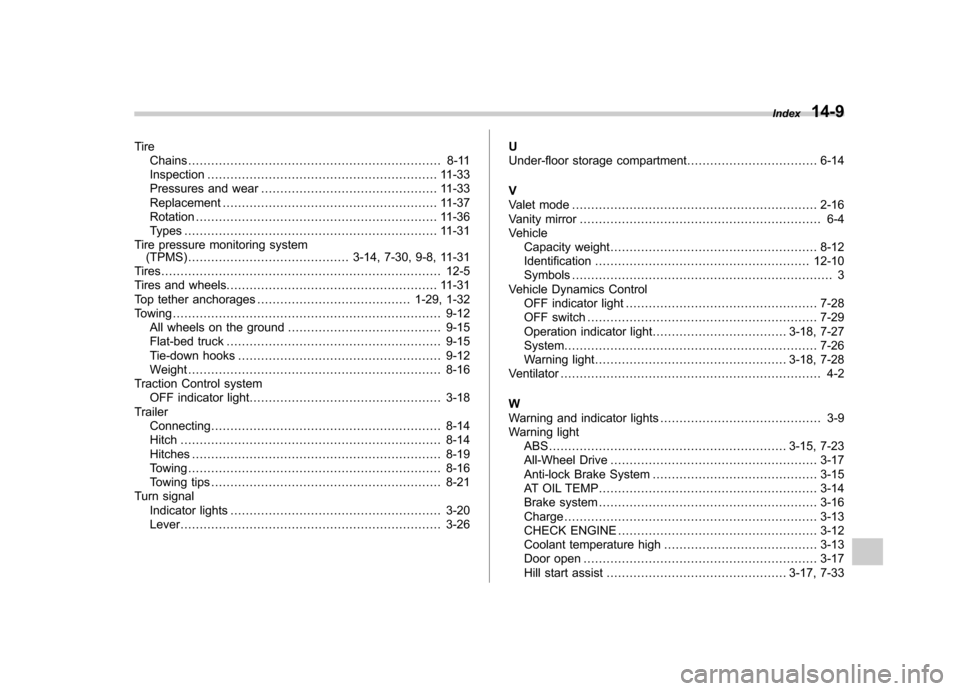
TireChains .................................................................. 8-11
Inspection ............................................................ 11-33
Pressures and wear .............................................. 11-33
Replacement ........................................................ 11-37
Rotation ............................................................... 11-36
Types .................................................................. 11-31
Tire pressure monitoring system (TPMS) .......................................... 3-14, 7-30, 9-8, 11-31
Tires ......................................................................... 12-5
Tires and wheels. ...................................................... 11-31
Top tether anchorages ........................................ 1-29, 1-32
Towing ...................................................................... 9-12
All wheels on the ground ........................................ 9-15
Flat-bed truck ........................................................ 9-15
Tie-down hooks ..................................................... 9-12
Weight.................................................................. 8-16
Traction Control system OFF indicator light .................................................. 3-18
Trailer
Connecting ............................................................ 8-14
Hitch .................................................................... 8-14
Hitches ................................................................. 8-19
Towing .................................................................. 8-16
Towing tips ............................................................ 8-21
Turn signal Indicator lights ....................................................... 3-20
Lever .................................................................... 3-26 U
Under-floor storage compartment
.................................. 6-14
V
Valet mode ................................................................ 2-16
Vanity mirror ............................................................... 6-4
Vehicle Capacity weight ...................................................... 8-12
Identification ........................................................ 12-10
Symbols .................................................................... 3
Vehicle Dynamics Control
OFF indicator light .................................................. 7-28
OFF switch ............................................................ 7-29
Operation indicator light ................................... 3-18, 7-27
System .................................................................. 7-26
Warning light .................................................. 3-18, 7-28
Ventilator .................................................................... 4-2
W
Warning and indicator lights .......................................... 3-9
Warning light
ABS.............................................................. 3-15, 7-23
All-Wheel Drive ...................................................... 3-17
Anti-lock Brake System ........................................... 3-15
AT OIL TEMP ......................................................... 3-14
Brake system ......................................................... 3-16
Charge .................................................................. 3-13
CHECK ENGINE .................................................... 3-12
Coolant temperature high ........................................ 3-13
Door open ............................................................. 3-17
Hill start assist ............................................... 3-17, 7-33 Index
14-9
Page 381 of 384

14-10Index
Low fuel .......................................................... 3-8, 3-17
Low tire pressure ................................................... 3-14
Oil pressure .......................................................... 3-13
Seatbelt .......................................................... 1-12, 3-9
SRS airbag system ................................................ 3-11
Vehicle Dynamics Control ............................... 3-18, 7-28
Warranties ..................................................................... 1
Warranties and maintenance ....................................... 8-16
Washing ................................................................... 10-2
Waxing and polishing ................................................. 10-3
Wear indicators ......................................................... 11-35
Wheel Alignment .............................................................. 12-5
Aluminum ............................................................. 11-38
Balance ............................................................... 11-35
Replacement ........................................................ 11-37
Windows ................................................................... 2-19
Windshield Washer fluid ......................................................... 11-38
Wiper and washer switches ..................................... 3-29
Wiper blades ........................................................ 11-40
Wiper deicer .......................................................... 3-32
Winter Driving .................................................................... 8-8
Tires ............................................................ 8-10, 11-31
Winter tire ........................................................ 8-10, 11-31
Wiper and washer ...................................................... 3-28
Page 384 of 384

GAS STATION REFERENCE
& Fuel:
! Non-turbo models
Use only unleaded gasoline with an octane rating of 87 AKI or
higher. ! Turbo models
Use premium unleaded gasoline with an octane rating of 91 AKI
or higher. If premium unleaded gasoline with an octane rating of
91 AKI is not available, regular unleaded gasoline with octane
rating of 87 AKI or higher may be temporarily used. For
optimum engine performance and driveability, it is required that
you use premium grade unleaded gasoline with an octane
rating of 91 AKI or higher. & Fuel octane rating:
This octane rating is the average of the Research Octane and
Motor Octane numbers and is commonly referred to as the Anti
Knock Index (AKI). Refer to the “Fuel ”section in this manual. &
Fuel capacity:
16.9 US gal (64 liters, 14.1 Imp gal) & Engine oil:
Use only API classification SM with the words “ENERGY
CONSERVING ”and the ILSAC certification mark (starburst
mark) displayed on the container.& Engine oil capacity:
4.2 US qt (4.0 liters, 3.5 Imp qt)
& Cold tire pressure:
Tire size P215/65R16 96H P225/55R17 95H
Wheel size 16 66
1/2J1 66 61/2JJ 17 67JJ
Pressure Front 30 psi (210 kPa, 2.1 kgf/cm
2) 32 psi (220 kPa, 2.2 kgf/cm2)
Rear 29 psi (200 kPa, 2.0 kgf/cm
2) 30 psi (210 kPa, 2.1 kgf/cm2)
Temporary
spare tire Size
T155/70 D17
Pressure 60 psi (420 kPa, 4.2 kgf/cm
2)
NOTE
For the Latin American models, there is a conventional tire installed under the floor of the cargo area.